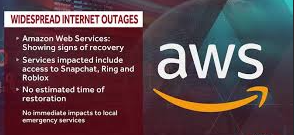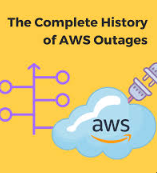Introduction to AWS and Its Importance
Amazon Web Services (AWS) has revolutionized how organizations manage their digital infrastructure. It provides an extensive suite of tools and services, including computing power, storage, and networking, making it a cornerstone for countless businesses across industries. AWS’s scalability allows companies to adapt to changing demands without the need for extensive physical infrastructure, offering flexibility that is especially valuable in today’s fast-paced digital environment.
Many well-known companies rely on AWS to support their critical systems, from streaming platforms to e-commerce websites. The platform’s global reach and vast data center network enable organizations to serve customers efficiently, regardless of their location. With AWS, businesses can focus on innovation and growth rather than being burdened by the complexities of managing their own infrastructure.

In addition to its core offerings, AWS provides specialized services such as machine learning, analytics, and IoT tools, catering to a diverse range of needs. These capabilities make it a versatile solution, whether for startups aiming to scale quickly or established enterprises handling vast amounts of data. As a result, AWS has become a key enabler of digital transformation, helping businesses stay competitive in an increasingly technology-driven marketplace.
Causes of AWS Outages
Several factors can lead to AWS outages, stemming from the inherent complexity of managing a global cloud infrastructure. Hardware malfunctions, such as server or storage device failures, are common culprits that can disrupt operations. Additionally, network-related problems, including latency or connectivity interruptions, can cascade across AWS systems, affecting multiple services simultaneously. While these issues can sometimes be contained, their effects can ripple outward due to the interconnected nature of cloud environments.
Software glitches also play a significant role in outages. Bugs in system updates or errors in configuration changes can inadvertently cause widespread disruptions. In large-scale operations like AWS, even minor mistakes can escalate into significant service interruptions, particularly when they affect critical components of the infrastructure. Routine maintenance or upgrades, while necessary, may introduce unforeseen complications, further emphasizing the importance of meticulous planning and execution.

Human error remains another contributing factor. Misconfigured settings, accidental deletions, or errors during deployment processes can lead to unexpected downtimes. Despite the implementation of automation and safeguards, human oversight continues to be a variable that impacts system stability. These errors highlight the challenges of maintaining seamless operations in a high-pressure, fast-moving environment.
External factors also contribute to AWS outages. Cyberattacks, such as distributed denial-of-service (DDoS) incidents, can overwhelm the system, leading to slowdowns or complete outages. Additionally, natural disasters or power grid failures affecting specific data centers may cause localized disruptions, which can then affect services dependent on those centers. The widespread reliance on AWS means that any regional problem has the potential to create a ripple effect across the internet.
Immediate Effects on Internet Services
An AWS outage can trigger widespread disruption across the digital ecosystem, as countless websites and applications rely on its cloud infrastructure to function. Platforms that support streaming, online transactions, communication tools, and various other services may face slow loading times, errors, or complete inaccessibility. These interruptions are particularly disruptive for businesses that rely on consistent digital performance to serve their customers.
For organizations dependent on AWS for hosting their applications, even a brief outage can interrupt essential operations. Employees may lose access to key tools, workflows may grind to a halt, and collaborative platforms may stop functioning. This not only affects internal productivity but can also extend to external interactions, such as delayed order processing or unfulfilled customer support requests.
The cascading effects of AWS outages often extend beyond the affected platforms themselves. Third-party services that integrate with AWS-hosted systems may also experience disruptions. For example, payment processors, delivery tracking systems, and other auxiliary tools tied to AWS infrastructure could become unreliable. This interconnectedness highlights how a single outage can reverberate across multiple layers of the online ecosystem.

Additionally, businesses that depend on real-time analytics and data-driven decision-making may face critical delays in processing information. Without access to the necessary tools and databases, they risk losing valuable insights during the downtime. This can hinder timely responses to market changes or operational demands, compounding the overall impact of the outage. Similarly, applications that rely on live features—such as multiplayer gaming platforms or stock trading apps—may leave users in limbo, unable to interact with or access the service.
For end users, the effects of an AWS outage can be both frustrating and disruptive. Social media platforms may become unavailable, preventing communication during critical moments. Users relying on cloud-based services to store files or access work-related resources may face delays in completing tasks. In some cases, even smart home devices or IoT systems dependent on AWS infrastructure may stop functioning, affecting day-to-day conveniences.
Consequences for Businesses and Users
The effects of an AWS outage extend far beyond technical disruptions, posing significant challenges for businesses and individual users alike. For companies, outages can lead to operational breakdowns as vital applications and services become inaccessible. Employees might be unable to perform their roles effectively, as tools for communication, project management, or customer relationship management may fail to operate. The interruption of these critical functions can create bottlenecks in workflows and hinder the delivery of products or services.
The monetary losses associated with outages can be particularly impactful. E-commerce platforms relying on AWS may lose sales during periods of downtime, while service-based businesses may miss out on revenue opportunities due to their inability to interact with customers or complete transactions. Such losses are exacerbated when an outage occurs during high-demand periods, such as holiday seasons or major promotional events. These moments are often critical for revenue generation, and any downtime can have long-term financial repercussions.
Beyond the immediate financial impact, trust and loyalty among users can be shaken. Customers expect reliability and may lose confidence in a service that experiences repeated downtime. This erosion of trust can lead to a decline in customer retention, as users may opt for alternatives perceived as more stable. For smaller businesses, the inability to meet user expectations during an AWS outage could have particularly dire consequences, potentially jeopardizing their growth and sustainability.
Users, on the other hand, face a range of frustrations when the services they depend on suddenly become unavailable. For professionals, cloud-hosted tools or platforms that facilitate remote work can become unusable, creating delays in deadlines and collaboration. This is especially problematic for industries where time-sensitive decisions rely on uninterrupted access to data or systems. Likewise, for consumers, the unavailability of services such as streaming, online shopping, or mobile apps can disrupt daily routines and create dissatisfaction.

Moreover, when AWS outages affect backend systems that support other third-party platforms, the problem compounds further. A single outage can impact multiple services simultaneously, creating a ripple effect that multiplies the scope of disruption for businesses and end users. For instance, food delivery apps, financial services, or customer support platforms reliant on AWS infrastructure might fail to function, leaving users with no alternatives to fulfill their immediate needs.
In some cases, AWS outages can also affect physical systems. Connected devices, such as smart home assistants or IoT-enabled appliances, may temporarily cease to operate, inconveniencing users who have integrated these tools into their daily lives. This highlights how even personal routines can be disrupted when cloud services experience downtime, amplifying the broader consequences of AWS outages.
Mitigation Strategies
To reduce the risks associated with AWS outages, businesses can focus on creating resilient architectures and implementing proactive measures. One effective approach is to design systems with redundancy in mind. By distributing workloads across multiple AWS regions or availability zones, companies can ensure that a failure in one area does not bring down the entire system. This strategy helps maintain uptime even when certain parts of the infrastructure face issues.
Another vital step is the adoption of automated monitoring and alerting tools. These tools can detect anomalies and potential problems within the cloud environment, allowing teams to respond quickly before the situation worsens. Leveraging automation can also minimize the chances of human error, which remains a significant contributor to outages. Regularly testing these systems and conducting drills to simulate failure scenarios can further prepare teams for real-world incidents.
Data backups are critical to maintaining operations during an outage. Implementing regular backup schedules and ensuring backups are stored in separate locations can help protect valuable information. In the event of a service disruption, businesses can recover lost data quickly and resume operations with minimal downtime.
For organizations with critical workloads, utilizing failover systems can provide an extra layer of protection. Failover mechanisms automatically redirect traffic or workloads to functioning resources when a failure is detected, ensuring uninterrupted service. This can be particularly useful for applications where continuous availability is essential, such as e-commerce platforms or financial services.

Testing the resiliency of applications through chaos engineering is another practice gaining traction. By intentionally introducing controlled failures into the system, teams can identify vulnerabilities and strengthen weak points. This method ensures that infrastructure can handle unexpected disruptions more effectively.
Diversifying service providers is another strategy that some businesses adopt to protect against potential outages. A multi-cloud approach allows companies to spread resources across different cloud platforms, reducing dependency on a single provider. While this approach may require additional planning and resources, it can significantly enhance overall system reliability.
Employee training is another often overlooked component of effective mitigation. Ensuring that staff members are well-versed in handling outages and familiar with recovery protocols can streamline the response process during critical moments. Additionally, maintaining clear communication channels with cloud providers allows businesses to stay informed about potential issues and planned maintenance activities, helping them prepare in advance.
Regularly reviewing and updating disaster recovery plans ensures that they remain relevant as systems and technologies evolve. Having these plans in place can make a significant difference in how quickly an organization can bounce back from an AWS outage.
Future Outlook for AWS and Internet Services
As cloud computing continues to evolve, AWS is taking significant steps to enhance the stability and reliability of its services. Efforts are being made to address current challenges by incorporating advanced technologies designed to mitigate risks and improve overall performance. The integration of artificial intelligence (AI) and machine learning tools into monitoring systems is expected to play a pivotal role in identifying potential vulnerabilities within the infrastructure. These technologies can analyze patterns, detect anomalies, and even predict failures, enabling faster response times and more effective prevention strategies.
AWS is also working toward expanding its global infrastructure to better handle the increasing demands placed on its services. By building additional data centers and enhancing the capacity of existing facilities, AWS aims to reduce the strain on individual regions and improve the availability of its resources. These investments will not only improve scalability but also make services more robust against localized disruptions, ensuring smoother operations for businesses worldwide.
Collaboration between cloud service providers and their clients is expected to grow stronger in the coming years. Providers like AWS are focusing on improving transparency regarding system updates, potential risks, and maintenance schedules. This enhanced communication allows businesses to better prepare for and manage downtime, fostering trust and minimizing the uncertainty surrounding outages.

The shift toward multi-cloud strategies is another trend shaping the future of internet services. Companies are increasingly diversifying their reliance on a single provider to ensure greater resilience against potential disruptions. While this approach introduces new complexities, advancements in cloud management tools are making it easier for businesses to efficiently manage resources across multiple platforms.
Additionally, the development of more efficient disaster recovery solutions is expected to further bolster the reliability of cloud-based services. New approaches to data replication and failover mechanisms are being designed to reduce downtime and ensure the continuity of critical operations during an outage.
As both businesses and individual users continue to integrate cloud services into their daily operations, the demand for stronger safeguards against outages will only grow. AWS, alongside other providers, is under increasing pressure to innovate and deliver solutions that keep pace with the expanding role of cloud computing in the modern world. These advancements promise a future in which outages become less frequent and their impacts significantly diminished, creating a more stable and dependable digital ecosystem.


